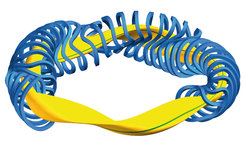Fusion energy and hidden symmetries
IPP scientists get grant from the Simons Foundation for further development of stellarator optimization
For treating the topic, Hidden Symmetries and Fusion Energy, Max Planck Institute for Plasma Physics (IPP) at Greifswald in conjunction with nine universities in the USA, Switzerland, the United Kingdom and Australia has been awarded research funds from the renowned Simons Foundation. The foundation was established in New York City by Marilyn and Jim Simons – he a mathematician, hedge fund manager and billionaire – to promote research in mathematics and other fundamental sciences.

The Hidden Symmetries and Fusion Energy project, which the Simons Foundation will support with an annual two million US dollars for four years, is dedicated to the development of new sophisticated methods of computational optimization of fusion devices of the stellarator type. The objective of fusion research is a power plant that like the sun is to derive energy from fusion of atomic nuclei. As the fusion fire needs over 100 million degrees to ignite, the fuel, viz. a low-density hydrogen plasma, ought not to come into contact with cold vessel walls. It is confined by magnetic fields and is suspended inside a vacuum chamber with almost no wall contact.
Unlike the circularly symmetric magnetic field of the competing tokamak concept, which ensures good particle confinement, the magnetic field of a stellarator at first glance exhibits no symmetry whatsoever. Nevertheless, stellarator fields may have hidden symmetries that should likewise lead to good particle confinement. A “quasi-symmetric” structure forms the basis of, for example, the HSX stellarator at Madison, Wisconsin. The Wendelstein 7-X stellarator at Greifswald, whose first experimental results are highly promising, also shows that a tailored magnetic field can improve confinement.
The international team of plasma physicists, mathematicians and IT scientists, headed by a scientist from Princeton University, aims to find the optimum magnetic fields with hidden symmetries. Their objective is to produce a palette of novel, interconnected mathematical and numerical optimization tools, called the Simons Stellarator Optimizer. Professor Dr. Per Helander at IPP Greifswald is in charge of applying this optimiser to new stellarator designs: “The funding”, states Per Helander, “will allow the participating institutes provision of eight additional scientist positions for the four years – a great boost for stellarator optimisation”.
